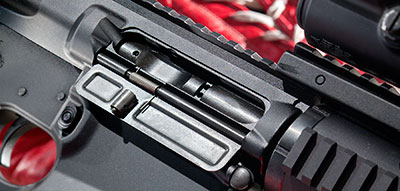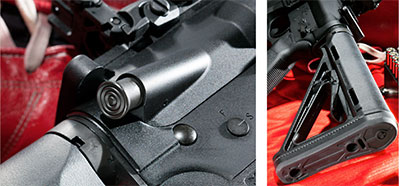
The AR-15-type rifle has become the sweetheart of American shooters and is said to be the most popular rifle sold today. The original AR platform is often called the AR-10 in reference to Eugene Stoner’s first .308 Win.-based design. But, it gets a bit more complicated when we use that term. The rights to “AR-10” are owned by ArmaLite, and the company is understandably territorial about its property.

Those manufacturers producing larger-size AR rifles have developed some creative names. DPMS calls its rifle the LR, as in LR308, LR338, etc. Rock River Arms calls its large-lower AR the LAR8, JP Enterprises’ is the LRP07, Smith & Wesson’s is called the M&P10 and Ruger refers to its model as the SR-762. The list goes on, and to avoid confusion, some shooters just call them AR308s. But that’s not correct either, as there are plenty of other cartridge options beyond the .308 Win./7.62 NATO. So, in the interest of continuity, I have started calling them AR-Large, or AR-L for short.
AR-L rifles are more powerful than the AR-15. With the headliner being the .308 Win./7.62 NATO cartridge, the guns are offered in a wide range of chamberings based on that parent case. From .243 Win. through the powerful .338 Fed., the AR-L rifles have serious power for hunting or self-defense. Toss in the 6.5 Creedmoor and even some of the short magnums that have been offered in the AR-L, and the platform is capable of just about any North American shooting chore.

One of the most popular AR-L rifles is the DPMS LR series. The guns are accurate, dependable and most importantly, affordable. The magazines for the DPMS rifles are different from those used by the ArmaLite AR-10. They are called “DPMS-pattern magazines” in shooting vernacular, and the design has become popular enough to be considered an industry standard.
When it comes to AR-L rifles, DPMS has what might well be the widest range of offerings available. At one end are the heavy-barrel, long-range models like the 24-inch, bull-barrel LR308. Mine weighs 16 pounds with a Leupold scope and a full 20-round magazine, and will shoot sub-MOA at any distance within the cartridge’s performance window. On the other end of the spectrum are the lightweight, M4-style AP4 carbines or even the 8-pound Lite Hunter. A quick count on the DPMS website resulted in 32 different AR-L rifles from DPMS. This diversity is one reason the company does so well in this market.

A lot of manufacturers might have adopted the attitude, “we are the best in this field so there is no need to improve,” but DPMS didn’t take that self-destructive route. Instead, it decided to build a better mousetrap, or at least a better AR-L rifle.
“The LR line was great,” Adam Ballard, MSR product manager for Remington Outdoor Company told me. “But like anything in life, there was always room for improvement.”
The improvement is the new line of AR-L rifles called the GII, for Generation Two. The GII is smaller and lighter than the old LR line. In fact, it is almost as small and as light as an AR-15. Current GII models start at just 7.25 pounds, with new introductions expected soon that will be as light as 6.9 pounds. Ballard added, “Depending on the model, the GII can weigh from 1 to several pounds less than its older LR counterpart.” That weight reduction was not possible with the old layout, so engineers changed the design of the upper and lower receivers and the bolt carrier.

The receivers are forged, 7075 T6 aluminum alloy that is anodized and Teflon coated. Its upper receiver includes a fully functional forward assist—the forward assist in the older DPMS LR guns only worked for the last 1⁄8-inch of travel. This resulted in some complaints from hunters who wanted to ease the bolt down slowly and use the forward assist to make sure the rifle was in battery. While there is some debate on the wisdom of this technique, DPMS believes in giving customers what they want, so the new model changed the design.
There is a larger ejection port on the GII and an improved shell deflector that won’t beat up brass as much, which pleases my handloader’s heart. The forged, monolithic bolt carrier in the GII eliminates the larger forward section used on the old-style bolt carrier, and it is the same diameter for its entire length, which reduces weight and size. The new bolt carrier measures .930-inch at its largest point as opposed to the old style at 1.135-inch, is .6-inch shorter than the old model and weighs 6 ounces less. The firing pin is titanium, further reducing weight.

All of these changes produce a significant reduction in the mass of the moving parts, so when you pull the trigger, there is less metal moving inside, meaning less slamming and banging when the action operates. Recovery is therefore faster and it’s easier to get the sights back on target. That means faster follow-up shots and shorter split times between shots.
The gas key on the new bolt carrier sits lower and is integral with the bolt carrier, again saving space. It is fitted with a gas-key extension that is pin-ned in place. The GII bolt uses new geometry for the locking lugs, where every edge has a radius, eliminating sharp edges and ensuring improved reliability. A new barrel extension is designed to mate with the new bolt. In addition, there’s a new feedramp design consisting of a steel insert pinned into the aluminum upper receiver for added strength.
There are two ejectors. Ballard said the extra ejector was added to help reduce spring fatigue, but it also introduces redundancy—the GII will operate with one ejector, so if one spring were to break, the rifle will remain in the fight. Instead of the standard wound-wire extractor spring, the GII uses an elastic, polymer button nicknamed a “tactical skittle.” Again, extensive testing has shown it to be about failure proof and far less prone to problems than a conventional spring. The extractor and “elastomer extractor spring” will retrofit to older DPMS LR rifles. Ballard says the company expects at some point in the future to incorporate the extractor and the polymer spring into all of the company’s offerings.

The barrel, gas block and gas tube are unchanged, and the GII will take most AR-15 handguards—offering many options for customization. Those models with threaded barrels use the standard 5⁄8x24 thread pattern, common to .308 Win. rifles, which helps ensure the right size muzzle brakes are used if you want to accessorize.
An integral trigger guard and a beveled magazine well are present on the lower receiver, and the buffer and buffer spring are standard for a .308 Win. AR. The GII will accept AR-type stocks and grips. The trigger is likewise standard and can use any of the current AR-L triggers if you wish to upgrade. GII rifles will, naturally, take DPMS-pattern magazines.
Currently, DPMS offers six models of the GII—the AP4, MOE, Recon, Hunter, Bull and SASS, in .308 Win. Hunter models will also be available in .243 Win., .260 Rem. and .338 Fed. in the near future.
From a self-defense standpoint, the Recon model I tested is the most interesting of the bunch. It’s a do-it-all rifle—more than accurate enough for long-range shooting and fast enough for CQB. It weighs 8.5 pounds and looks cool. When DPMS introduced the GII to a bunch of writers, there were a mixture of models on the rack, but the Recons were chosen first. Why? Aesthetics. The Recon looks like a tactical rifle should.

For a rifle that can do it all, I pick the Recon. It may not be as good as the specialized models in specific areas, but for the widest range of uses it’s hard to beat. I know of several shooters who are using this version with a few modifications in the Heavy classes of 3-gun competition.
The Recon has a bead-blasted, stainless steel 16-inch barrel with low-profile gas block and a mid-length gas tube. The three-pronged flash hider is an AAC Blackout 51T model designed to accept a suppressor from AAC. With the increasing use of suppressors, this is a good idea. The fore-end is a quad-rail freefloat tube. While the four-rail design has fallen a little bit out of vogue recently, I like the positive feel this fore-end provides. The Recon has an adjustable Magpul MOE buttstock and an MOE grip.
Shooting five, five-shot groups, the Recon ran slightly larger than 1 MOA across the board. It is not a fussy eater and shot well. In testing several GII models, I fired more than 1,000 rounds and experienced no stoppages. The models I tried always went bang and ejected empties.
The GII proves an AR-L rifle does not have to be big and heavy, but can be light, responsive and still function flawlessly. It is going to change the way we think about AR-L rifles and set the standard for a lighter, more user-friendly firearm design. The GII is destined to influence any company making AR-Ls in the future.





































